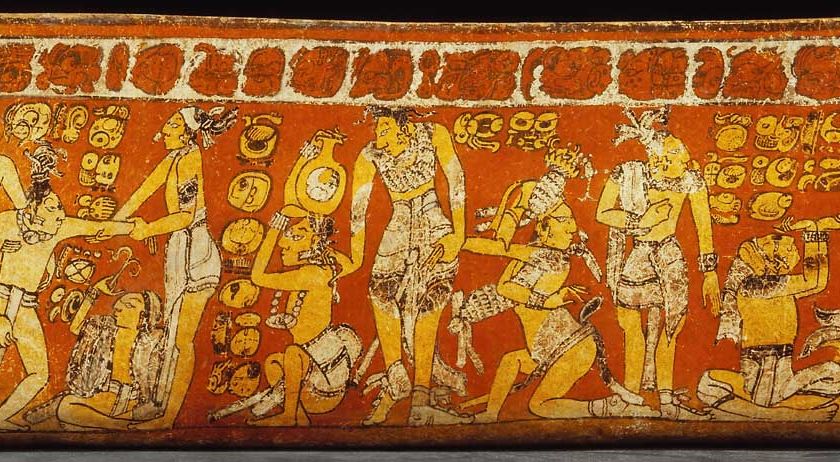Did Mayan people get drunk from enemas? This scientist put it to the test
-
 Mayans administering ritual enemas. Image on antique vase. Copyright: Justin Kerr
Mayans administering ritual enemas. Image on antique vase. Copyright: Justin Kerr
Did Mayans self-administer mind-altering substances with enema rituals? Professor Emeritus Peter de Smet won an Ig Nobel prize last week with an art history research into that question. The pharmacologist is very happy with the award. "It means I have achieved something in the field of art history."
‘This must be a joke.’ That’s what Peter de Smet thought when he received an email saying he had won an Ig Nobel prize. Such a prize is awarded to scientific research which first makes you laugh but which always gives people food for thought.
Brussels antiquaries district
De Smet, former professor of Quality of Pharmaceutical Patient Care at Radboud University and Radboudumc, received the prize in the category Art History for a scientific article from 1986. The article was about images of ritual enemas – fluids administered rectally – on antique Mayan crockery. The Mayas were a pre-Columbian civilisation that had its heyday from around 250 to 900 AD in Guatemala and neighbouring countries.
De Smet remembers well the first time he came in contact with Mayan art displaying images of ritual enemas: it was in the Brussels antiquaries district in the early 1980s. He was shown an unusual vase with an enema ritual on it, by a dealer in primitive art who knew De Smet’s taste. De Smet was immediately impressed by the vase.
He has been intrigued by pre-Columbian archaeology since his secondary school years. “I would have liked nothing better than to study archaeology,” the scientist says. “But because my parents were afraid I would be financially dependent on them for the rest of my life if I did, I chose to study pharmacy.”
What is the Ig Nobel prize?
Every year, since 1991, the Ig Nobel prizes have been awarded in the run-up to the real Nobel prizes. The organising committee is located in Boston and the award ceremony took place on Thursday night/Friday morning. Winners of an Ig Nobel prize receive one trillion Zimbabwe dollars, a currency which is sadly no longer in use. In 2019, professor of Infection Prevention, Andreas Voss of Radboud University, won an Ig Nobel prize in Economics for research into dirty banknotes and in 2015, researcher Mark Dingemanse won an Ig Nobel prize for his research into the word ‘huh’.
Back to Brussels of the 1980s. After De Smet’s visit, the American anthropologist Nicholas Hellmuth gives a lecture on Mayan vases. De Smet, who attends the lecture, gets talking to the anthropologist afterwards. Hellmuth turns out to have a large database with photos of Mayan art.
De Smet decides to travel to Austria, where Hellmuth is residing at that time, and together they make a list of enema images in Mayan art. And this results in the article in which the researchers demonstrate that Mayans may well have self-administered mind-altering substances with enema rituals.
Pulque
The fact is that the two researchers find many indications of enema rituals in Mayan art. Often, an enema syringe is pictured, generally made from a calabash gourd to which a bone tube has been attached. In some of the images, an enema is being administered with that tube, on others, it’s lying on top of a large pot full of enema fluid.

Mayan art with ritual enemas in the MoMa, in New York. Photo: Justin Kerr
Based on a Maya glyph – a character in Mayan script – on such a pot, De Smet suspects that the Mayans self-administered pulque: a Mesoamerican (belonging to the cultural historic area that stretches from Central America to Nicaragua, ed.) beverage with quite a low alcohol percentage. “But that doesn’t have a particularly strong effect,” says De Smet. “They may well have supplemented the alcoholic beverage with a substance with a stronger effect, such as a hallucinogenic plant.”
Vomiting
The question remains as to why the Mayans self-administered enemas. De Smet lists the various hypotheses. “Some of the participants in the enema rituals on the vases are vomiting,” he says. “That’s a way of getting rid of everything you have ingested. So it might have been a way of administering extra alcohol when you had already had enough.”
Interesting: the vomit pictured on the vases is red in colour. “We know that the old Mayans pierced their tongues with a sharp object so that they could offer blood as a sacrifice. The enemas might have been a part of a sacrificial ceremony.”
‘The enemas might have been a part of a sacrificial ceremony’
De Smet also found rectal administering in an initiation ritual by the Jivaro, a South American Indian people. “The adult males of the tribe formed a line, holding a pottery bowl containing an extreme hallucinogenic. In order to connect with all the men of the tribe, the young males had to take a few sips from each bowl. Often, they didn’t make it to the end of the line because they were already hallucinating. The bowls they hadn’t finished drinking were then administered as an enema.
Rectal administering
De Smet’s fascination for Mayan art was great, as the 1986 article shows. At a certain point, he self-administered an enema with alcohol. “I wanted to know how quickly alcohol administered through an enema enters the bloodstream,” he says. “So in the toxicology lab in Utrecht, I lay down on a camp bed and rectally administered myself with an alcoholic beverage. Using breath analysis, I was able to monitor how fast the alcohol percentage in my blood increased. The concentrations were comparable to those you get when you drink alcohol.”
‘I wanted to know how quickly alcohol administered through an enema enters the bloodstream’
De Smet later carried out an experiment, rectally self-administering DMT, a substance with an effect similar to LSD. DMT can be found in South American plants that were used to generate hallucinations. “If you take DMT orally, the substance is broken down by the liver before it can reach the bloodstream. But what happens when it is administered rectally was unknown until then. That’s what I wanted to test.”
Wasn’t that dangerous? “No, I first took a small dose,” says De Smet. “When I didn’t feel any effect, I increased the dose. The only thing that could have happened was that I started hallucinating. For that reason, a doctor friend supervised the experiment. But I don’t know whether such an experiment would be allowed these days,” he laughs.
Mucous membranes
Research done by Ig Nobel prize winners mustn’t only make scientists laugh, it must also get them thinking. The Maya research definitely has a social significance, according to De Smet. “All over the world, young people are still self-administering alcohol rectally, and they regularly land up in hospital. That happens when the beverage has an alcohol percentage of 40% or more.”
‘The rectum and the colon are lined with mucous membranes’
De Smet points out that if young people had read his acclaimed article, they could have known that. “The rectum and the colon are lined with mucous membranes. When they come in contact with high percentages of alcohol, they can become severely irritated and inflamed, which can lead to hospitalisation.”
De Smet, who during his emeritus still spends a great deal of time on ethnopharmacology or folk medicine, declares himself to be very honoured by the Ig Nobel prize. “It means that in addition to pharmacology, I’ve also made a difference in the field of art history. And that’s something I dreamed of as a child.”




